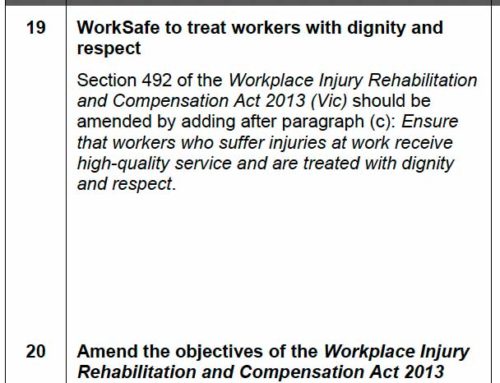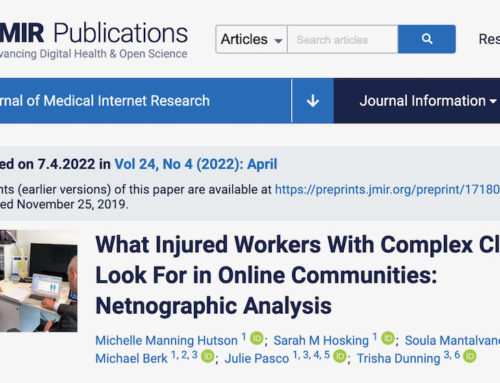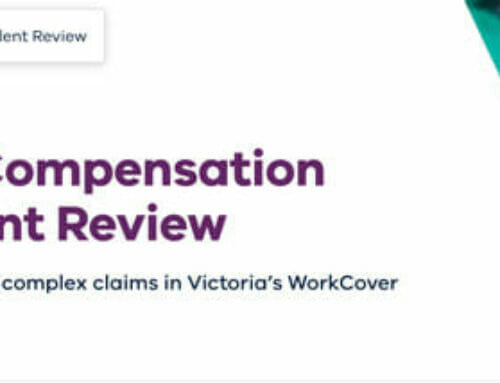
Surfing the many ‘pain’ forums you eventually get to ‘cyber’ know the regular contributors. One of my favorites to bump into is the highly accredited and regarded, John Quintner. I give full attention too John, he is a great support for me (and to the world of pain). Regular readers of my blog might remember his previously posted paper ‘John Qunitner’s point of view‘ and may have also seen some of John’s great comments, in particular where I vent my frustrations with WorkCover.
But this post isn’t about me, it certainly interests me as it refers to assessments within the WorkCover system. Although John speaks for WA this does also apply for Victorian injured workers. I’m happy to be able to post this on my blog, although flattened and left without acknowledgement with my personal WorkCover impairment. I still hold hope our out-of-date system will be updated someday and it will be opinions such as these that will instigate that change. Future injured workers should be grateful for them.
If you haven’t come across John Quintner then my advice would be to google his name, he has some great opinions to share about chronic pain.
Dr John Quintner. Consultant Physician in Rheumatology and Pain Medicine
Mr Chris White, CEO, WorkCover WA (WA compo compares favourably, June 2013) rightly calls for factual information to support any suggestions as to how the scheme he administers could be improved.
In so doing, he has sidestepped the call for reform of the system made by pain specialists Drs John Salmon and Stephanie Davies (Management of WA’s work injured needs reform, May 2013).
Does WorkCover have a case to answer or are these experienced pain specialists making a big fuss about nothing? Well, let’s look at some facts.
In the WorkCover WA Guides for the Evaluation of Permanent Impairment (3rd edition, 2010), we read that because there is currently no validated measurement tool for the assessment of pain, WA has followed the NSW WorkCover Guides by excluding Chapter 18 (The Assessment of Pain) of the AMA(US) Guides V.
Without providing any factual evidence to bolster its position, WorkCover WA claims that pain has already been factored into the impairment ratings for demonstrable work-related conditions.
If that were indeed the case, extrapolating from this administrative decision, one might reasonably expect to find that the Guides being used in WA (and NSW) rely upon the use of validated measuring tools to determine the extent of bodily impairment.
But that is not the case: there are hardly any studies that would validate the assessment of physical impairment currently being used by WorkCover. [Davies, 2008]
This is doubly detrimental to the injured worker with ongoing pain and apparently little or no assessable impairment. Contrast this to the attempt to resolve the vexed question of psychiatric impairment.
Here, not only does WorkCover WA use ‘impairment’ as a surrogate term for ‘disability,” but also Approved Medical Specialists (AMS) are mandated to use the Psychiatric Impairment Rating Scale (PIRS), which was constructed by an expert group of NSW psychiatrists.
The PIRS comprises six subscales, each of which is said to delineate and evaluate discrete areas of functional impairment: self-care and personal hygiene; social and recreational activities; travel; social functioning (relationships); concentration; and employability.
Data on the reliability and validity of the PIRS has yet to be published by NSW WorkCover, although it did fund such a study in 2003. [Davies, 2008] Could it be that the results were inconclusive (or even worse than that)?
Furthermore, the final calculation of impairment rating using the PIRS is skewed towards the lower scores, thus reducing the overall amount of compensation paid. [Davies, 2008]
But at least workers with psychiatric impairment/disability are afforded a mechanism of sorts for assessing their entitlements. Why are workers with chronic and disabling pain being denied the same opportunity?
Given that each of the original PIRS subscales applies equally to the assessment of pain-related impairment/disability, WorkCover could easily formulate a Pain Impairment Rating Scale. This would rectify the glaring anomaly and ensure both equity and consistency in AMS assessment.
As an additional benefit, it would remove the stigma of chronic pain that appears to have become part of the workers’ compensation culture in WA.
This benefit would spin off into the world of third party insurance where, according to Drs Salmon and Davies, insurers currently seem to be following WorkCover’s lead and are denying injured workers early access to evidence-based assessment and pain management that, ironically, would likely improve return to work outcomes.
Mr White refers to the balancing act to ensure that the requirements and interests of participants in the scheme are being met. The recommendations made by Drs Salmon and Davies should be seen in this light and not swept under the carpet, yet again.
Davies GR. The psychiatric impairment rating scale: is it a valid measure? Australian Psychologist 2008; 43: 205-212.










I was treated by Dr Salmon in 2009 and have a IPG with 2 leads in my back, I was on workers comp and they paid for the trial but had to take out HBF to afford the full implant. Since the implant and healing time I have returned to the workforce and even back to playing my beloved Cricket. Theres not a year goes by that I dont think of Dr Salmon and the Wray street clinic that I frequented between 2007 & 2010. Dr Salmon is absolutely brilliant in his field and is the most influential specialist ive ever dealt with